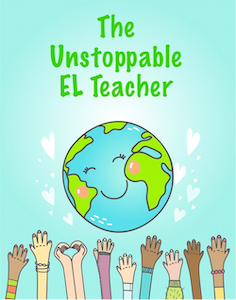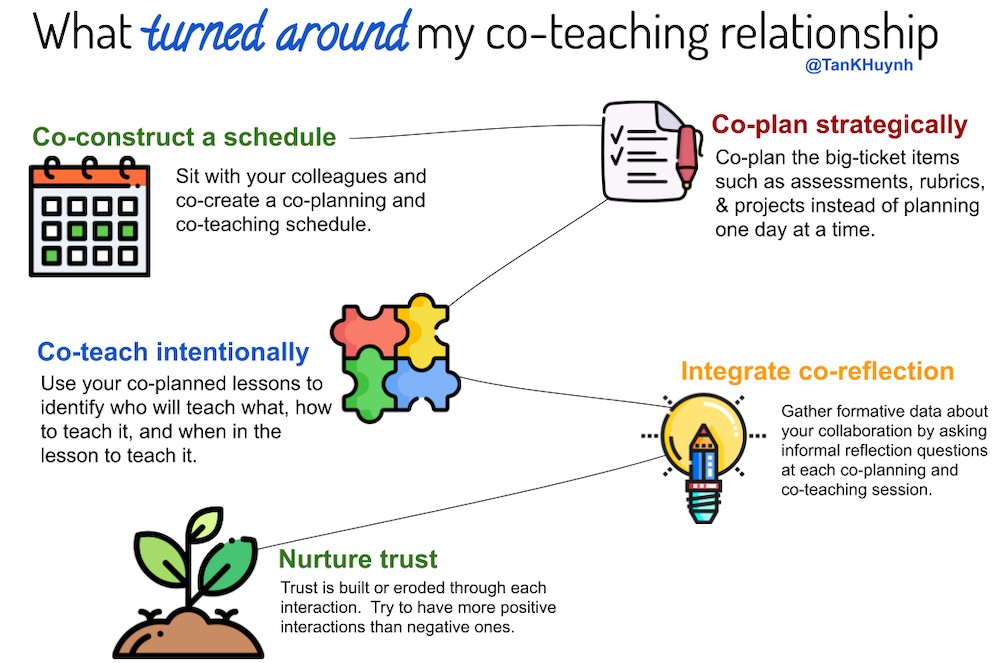Turning Around a Co-teaching Relationship
A MiddleWeb Blog
 Every teaching partnership has a story. One of my partnerships started off quite rough but became the most collaborative experience of my 13 years teaching.
Every teaching partnership has a story. One of my partnerships started off quite rough but became the most collaborative experience of my 13 years teaching.
This article not only summarizes the highlights of my podcast conversation with Shawna Carnahan, one of my co-teachers, but it also is a reflection of how we turned our collaboration around.
Without a Plan

Shawna Carnahan
The year we started working together was when we both taught 5th grade. Shawna had already worked in the school for a year, and I was just entering my first year.
The year I joined was also the first year each grade in the elementary school had a designated language specialist, so everyone was trying to figure out the definition of that role. All we knew was that I had to work with the five grade-five teachers and work with their multilingual students.
We had an in-class support schedule where I went to classes to assist students. But unfortunately, I failed to establish a co-planning schedule with each teacher individually. We only met during grade-level team meetings. My intention was to co-plan, but with five teachers on the team, it was impossible to “group plan” with each teacher having a different teaching style.
I spent most of that first year in classes supporting language learners, but there was very little co-teaching. That was a predictable outcome since one cannot truly co-teach without co-planning first.
Because we could not co-plan, we lost the ability to know each other as people and professionals, and to draw on each other’s skills and experiences. Co-planning is not just for instruction. It also serves to incubate a newly born teaching relationship. Without co-planning time, I usually was resigned to supporting from the side.
Restart with Co-planning
I returned the second year with renewed hopes for dynamic teaching relationships. Now that I was no longer a new teacher at the school, I understood the school’s systems and how I could fit into them. Therefore my first goal was to establish a schedule with my team. At one of the meetings, I had them co-create my schedule. My only criteria were:
- There must be one co-planning period per 10-day cycle
- Schedule co-teaching times during double blocks (i.e, 70 minutes of instruction), no more 35-minute co-teaching blocks
- More time given to teachers with more language learners
With a co-planning and co-teaching schedule made, I now had the opportunity to start over with trying to form a dynamic teaching partnership.
Co-plan Strategically
There were two strategic things I did that made co-planning successful with Shawna. Unlike the first year – when some of my colleagues wanted me to plan literacy lessons they would teach – I co-constructed lessons with teachers who wanted to co-plan. With this approach, I was able to support instruction in ways that felt familiar and comfortable to Shawna because I simply built on her ideas and worked to be responsive to her personal teaching style.
The second thing I did was use the collaboration time to engage in High-Impact Co-planning, which is characterized by the following phases:
- Phase 1 – plan the unit’s assessment tasks and rubrics
- Phase 2 – plan backward from the assessment
After planning the assessment tasks and rubrics, I was able to focus on planning at the weekly level. I would always ask, “What do we want students to do by next Friday.” This simple question would always lead us back to the assessment tasks and the rubrics.
We would outline our ideas on a week-at-a-glance document. Co-constructing this document made our instruction crystal clear, which in turn made our collaboration much more defined (Frey, Fisher, & Hattie, 2016).
One trick that really made formatting easy was as we were co-planning, I turned our ideas into visuals directly on the teaching slides. This helped capture the ideas, made them visual, and empowered us to co-construct the big ideas to put on the slides together.
Once we settled on the major push for the week ahead, I added the finishing touches during my personal prep time. It was a better investment of co-planning time to agree on the objectives of next week’s lessons than planning out all the small details for each day.
Shawna trusted me enough to leave much of the formatting of the teaching slides to me. This freed her up to do other work and left her feeling that she has an ally in me.
Co-teach Intentionally
Co-planning intentionally effortlessly blossomed into co-teaching strategically. By the end of every co-planning session, we had these key co-teaching questions answered:
- What are we teaching?
- Who is teaching what?
- How will we teach it?
- When in the lesson sequence am I teaching that?
Whenever it was Shawna’s turn to teach, I still stood in front of the room to help scribe ideas, to facilitate conversation, to model a process, and to add ideas. I cannot emphasize enough the power of scribing for your co-teacher because it communicates support and collaboration.
Scribing also allowed me to add ideas more easily than I could from the back or side of the room. I could add with confidence because we had already co-planned, and Shawna and I used a single presentation document.
Even when she led a lesson, I was intimately familiar with the lesson because I often took our ideas and formatted them on our teaching slides. This made co-teaching feel fluid (to us and to our students) like a balanced, coordinated dance.
Whenever I taught, I stood at one side of the board to subconsciously make space for Shawna to join. My body language communicated that I wanted to share the teaching with Shawna, never take over. Additionally, as we co-taught and while students were working on the task, I would often come check in with Shawna to share our observations and determine if it was time to move onto the next phase of the lesson.
When I led a particular lesson, we made decisions jointly. This was purposeful because I knew that I was a guest in her room, and I wanted to nurture a truly collaborative relationship.
Incorporate Mini-Reflections
As part of the Collaborative Instructional Cycle, co-reflecting is essential (Honigsfeld & Dove, 2019). Fortunately, co-reflecting can occur throughout the collaboration and not just the end. I often would ask, “What did you think about how we did [x or y].” This simple question would allow us to informally reflect, which then led to more refined instruction.
Sometimes I would do this just after we co-taught; or at the beginning of a co-planning session, after looking at students’ work together; or after a co-planning session. Informal reflection was an integrated part of our collaboration.
Nurture Relational Trust
In our podcast conversation I asked Shawna what she thought helped turn our collaboration around. She kindly said that I was persistent in working together. She also said that I had no ego about working together. Together, this formed our relational trust (Bryk & Schneider, 2003). I did specific things to nurture our relationship (even during our first year) such as:
- doing small acts of kindness (e.g. erasing the board, setting up the projector)
- building on her ideas instead of offering completely new ones
- finding moments to celebrate and things to positively recognize
These moments did occur during co-teaching, but they occurred more often during co-planning as co-planning without students present is a more relaxed and safer place – and a less territorial space – to form trust.
The releasing of control and sharing of a classroom starts during co-planning. For many who have not co-taught before, they need to feel that the language specialist will not evaluate them, will be affirming, and will make them feel comfortable working as a team. Co-planning is the nursery for collegial trust.
My Most Collaborative Relationship
If you had told me in advance that, by the end of my second year working with Shawna, it would be one of the most transformative partnerships and the most collaborative teaching relationship ever, I would have doubted you.
However, when I look back at our turn-around story, it was all possible because we created a schedule that included co-planning time and used co-planning strategically to focus on the big aspects of the unit.
If you had walked into Shawna’s room to watch us co-teach (above), you would have thought that we had been co-teaching together for many more years, not just two. It certainly felt like we had a dynamic co-teaching relationship on the surface. What people might not realize is that below the co-teaching success was a foundation of co-planning.
In the comment section, share your own turnaround collaboration story if you have one. I hope you do, or will one day soon.
References
Bryk, A., & Schneider, B. (2003). Trust in Schools: A Core Resource for School Reform. Educational Leadership, 60(6), 40-45. Retrieved July 5, 2020, from http://www.ascd.org/publications/educational-leadership/mar03/vol60/num06/Trust-in-Schools@-A-Core-Resource-for-School-Reform.aspx
Fisher, D., Frey, N., & Hattie, J. (2016). Visible learning for literacy, grades K-12: Implementing the practices that work best to accelerate student learning. Thousand Oaks, CA: Corwin Literacy.
Honigsfeld, A., & Dove, M. G. (2019). Collaborating for English learners: A foundational guide to integrated practices. Thousand Oaks, CA: Corwin.




































